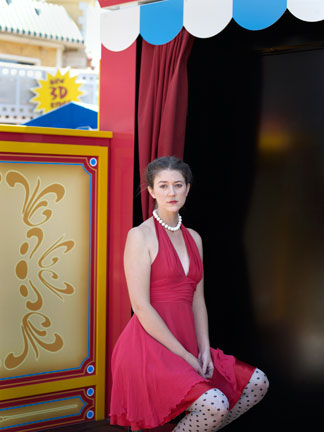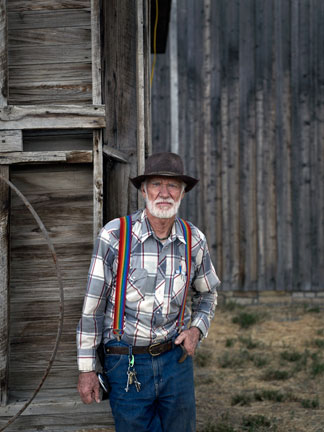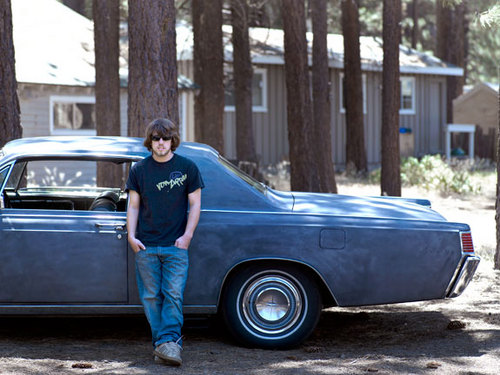- March 18, 2009
- Posted by Marc
David Eustace Follows Highway 50 For USA Network’s New Book American Character: A Photographic Journ

Lindsay Benner, performer at Pier 39, Fisherman’s Wharf, San Francisco

Richard E. Fike, retired archaeologist; owner and founder of the Museum of the American West, Montrose, Colorado

Tony Allison, U.S. Forestry Service Firefighter and Snowboard Instructor, Lake Tahoe, California
Earlier this week the book “American Character: A Photographic Journey” hit stores (and Amazon) across the country. Conceived by USA Network the book showcases the work of eleven amazing photographers who were tasked with capturing “the character of America”.
Of all the photographs in the book we were particularly struck a series of portraits shot by the Scottish photographer David Eustace along the legendary Highway 50.
Here’s how he describes his work in the new book:
“Photography has afforded me many luxuries in life, but probably none more valuable than the excuse it has given me to approach complete strangers whom I find interesting and ask if they would allow me to take their portraits, and while doing so, tell me a little about their lives. Most of these encounters last for a relatively short time; the memories, however, surpass what is caught either digitally or on film.
For Character Project, my intention was straightforward enough: I wanted to explore the diversity of people connected by a single road and create a body of work comprised primarily of portraits juxtaposed against varied landscapes. I chose to follow Highway 50, an artery that stretches over three thousand miles and connects the Pacific to the Atlantic Ocean. It is often referred to as “The Loneliest Road in America” or “The Backbone of America.” This old road cuts through twelve states and four state capitals, rarely intersecting with newer freeways as it stretches from coast to coast. It winds across the deserts, mountains, plains, and forests, and it bears witness to both the old and the new United States.
The trip was deliberately very loose in the planning, as I wanted it to serve also as an exploratory trial run for future trips. The only criterion, due to prior work commitments, was that I had to arrange, produce, and complete the project in less than three weeks. Taking one assistant, I would drive an SUV from San Francisco to Ocean City, Maryland. We would drive with the hope of meeting people who I felt had the charisma, character, or individuality to stand out, and who were willing to let me take their photograph.
At the Museum of the Mountain West in Colorado, I met the owner and founder, a retired archaeologist who, among many other things, had carried out excavations at the site of Little Big Horn, where General George Custer and 220 of his cavalrymen died at the hands of Sioux and Cheyenne Indians in 1876. He knew men who had known Billy the Kid and Buffalo Bill.
I met a man who was born in Texas and grew up on a cattle ranch in Idaho before moving out to Carmel, California, where he worked for and later became “a very close friend” of Ansel Adams and his wife. He told me stories of sitting in the Hog’s Breath Inn and sharing a beer with the owner, Clint Eastwood.
I came across a wonderful old lady who told me about her life as a girl in Winchester, Virginia, and how she grew up “at 604 and Patsy [Cline] grew up right next door in 605.”
I shared a beer and a laugh with the lady who owns the oldest bar in Fallon, Nevada—a bar that hasn’t changed much since the likes of Butch Cassidy and Teddy Roosevelt used to sit there.
I was also fortunate enough to photograph Bob Cassilly, the pioneering artist responsible for the City Museum in St. Louis. While in the Utah desert, I encountered a man who had just driven over two thousand miles to rescue four dogs from abandoned dog kennels.
I met a young student in Ohio who dreamed of “setting foot on all seven continents.” And I came across a man who, with three of his colleagues, had formed the Chicago Four, a group that successfully took the American Medical Association to the Supreme Court to have chiropractors recognized as qualified doctors
and practitioners.
In the final days of this project, I came across a sign that read: “Faith makes things possible, not easy.” It made me smile as I realized how true this statement was with my three-thousand-mile journey almost complete. I had left it all to faith, chance, luck—call it what you will—but my adventure had allowed me to photograph fifty people I had not known only three short weeks before. Even though I was a total stranger, every last person I approached agreed to take part in my project. I met some incredibly honest, simple, straightforward, unpretentious, friendly, and memorable American characters along the way. And each and every one of them made me feel so very welcome.”
